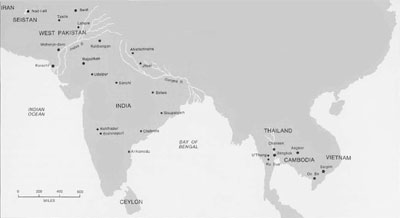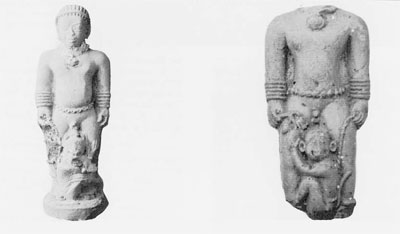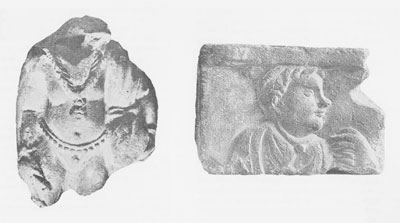 In 1968 and 1969 the University Museum team of George Dales, Bennett Bronson, and Elkins Weatherill in conjunction with members of the Fine Arts Department of Thailand conducted an excavation at Chansen, Nakhon Sawan province in central Thailand, near Lopburi. The site had been chosen because farmers in the previous year had turned up potsherds, figurines, amulets, and other objects of unusual or unknown types, and also because aerial photographs showed that there had been an ancient town of about 700 x 700 meters contained within a moat, a small site which might be excavated in one or two seasons.
In 1968 and 1969 the University Museum team of George Dales, Bennett Bronson, and Elkins Weatherill in conjunction with members of the Fine Arts Department of Thailand conducted an excavation at Chansen, Nakhon Sawan province in central Thailand, near Lopburi. The site had been chosen because farmers in the previous year had turned up potsherds, figurines, amulets, and other objects of unusual or unknown types, and also because aerial photographs showed that there had been an ancient town of about 700 x 700 meters contained within a moat, a small site which might be excavated in one or two seasons.
The technical report on Chansen is being done by the excavators; these notes are concerned merely with the identity and historical significance of a group of unusual figurines from the site.
The molded terra-cotta figurines, 6-7″ high, are of two main types: a standing, nude, youthful male, and a standing, full-busted female wearing a long skirt.
The first male figure which appeared in 1966 was a surface find at Chansen, and was rapidly followed by another find at U’Thong. Several of these are now known.

(Right) Figurine of boy giving fruit to the monkey. Private Collection.
One pictured here is a typical example of Type A. The figurine, about 7″ high, cast in a mold, shows a stocky, boyish male, nude except for the adornment of bracelets, amulet, and belt. The face is round, with large oval eyes, arched eyebrows, a broad nose, and a broad smiling mouth. His hair is dressed in strands, pulled up to a center topknot, and bound with a fillet around the forehead. Closely fitting around his neck, like a torque, is a band or chain to which is affixed a pendant. He wears several plain bracelets on each arm, and a knotted or link belt low over his hips. He stands on a rough base and between his legs squats a monkey clinging to the boy’s thigh.
In other examples, it is clear that in one hand the boy holds a rope which is fastened to the monkey’s harness, and usually in the other hand he has a bit of fruit for the animal.
There is another version of the “monkey boy,” Type B, which is far more crudely made and wears a somewhat different neck ornament. The broad, smiling face and the treatment of the hair are the same as in Type A, as are the low-slung belt and the arm bracelets. The trefoil-shaped pendant, however, is suspended from a thick cord which is draped around the shoulders and tied in the back. The ends of this neck sash are tasseled and hang down nearly to the waist.
In one example excavated at Chansen by the University Museum team no monkey appears although there is room for him between the legs. He does exist in other Type B figures and in this case may have been made separately and not well affixed. The boy holds a grape-like cluster in one hand, probably the loin yai or maprang fruit. The object in the other hand may also be fruit tied by the stem, or perhaps a small water bottle.

The figurine came from a level called Phase V in the Chansen chronology. The same stratum references and a seal inscribed “King of Dvaravati” found at U’Thong, is the fact that such a kingdom existed. We do not know when it was established, or where was its capital. Neither Chansen nor U’Thong seems rich enough in monuments to have been the capital, but they do show a continuous habitation from at least the 2nd century A.D. through the Dvaravati, up to the 10th or 11th century, and they must have been part of the Dvaravati empire.
The female figures from Chansen are about the same size as the male ones. A typical example pictured here shows a figure of heavy proportions. The face is round, the eyebrows prominent, the nose broad, the mouth parted to show the teeth. The hair is in large flat curls. She wears large earrings and a neck ornament with a double loop in front, a single one in back. There is one heavy bracelet on each arm. She wears a long sarong with a pocket fold on the right side. The skirt bells out slightly hiding the feet on a small base.
In the collection of the Chansen war (temple) there is an interesting fragment which may have some relation to this figure. It is the lower half of a female figure with a child pressed against her simple lapped skirt. The hair of the child, a small girl, is dressed in strands and pulled into a topknot, similar to that of the monkey boy.

Beyond saying that the figurines, male and female, are of the Dvaravati period we must leave a more exact date in abeyance until further excavations and tests. The questions at this time are what was the inspiration for these figurines, unique in Southeast Asia, and what was their role in this early culture.
The Dvaravati art style of the Buddha image is derived from India, Gupta and post-Gupta periods (3rd-7th centuries) and probably not from one single center. We have not been able to find any exact parallel in India for these figurines, but there are some stylistic similarities. The terra-cotta statuettes of Ahichchhatra (5th-6th century) show a tightly curled treatment of the hair similar to that of our female figure, and a style of strands and topknot like that of the male. There is also from the same site a headless figure of a robust woman holding a child. There is another such figure from Jhusi of the Late Gupta period, and also a terra-cotta head with the large curls.
In the Patna Museum, figurines of the early Gupta period from Belwa show the large eyes and thick lips. In Rajasthan, near Udaipur, there are a series of stone figures, Gupta and post-Gupta, of women holding children. In one example, the child clings to the mother’s skirt.
These general similarities with the Gupta style are present in Dvaravati sculpture as a whole; what is not found in India at this time is a human figure with the combination of the animal-like, round, protruding eyes and bared teeth. The dwarf may have such eyes but not the menacing teeth. In Thailand, these round, pop eyes are called “crocodile eyes” and are one of the characteristics of a demon. A few examples of this type appear in the Ku Bua site of the Dvaravati period. Certainly the iconography is firmly fixed by the Khmer period, 10th-13th centuries. In both sculpture and relief, the demons who struggle with the gods are clearly identifiable by their round eyes and slightly visible fangs.
The Chansen figurine must represent a female demon, perhaps a local phi, or bad spirit, perhaps Mara, temptress of the Buddha, or the ogre, Hariti, devourer of children before she was converted to Buddhism and compassion.
There is a somewhat more definite, and surprising, Indian background for the male figurine, the “monkey boy.” From Taxila in northwest India, the area of Graeco-Roman artistic influence, there exists a first century A.D. figure of a nude boy holding a bird in one hand. Around the boy’s neck is a ring suspending the same slightly trefoil ornament as the Thai figurines. Excavations of Satavahana date. 2nd-3rd century, at Brahmapuri produced a nude torso of a boy holding a bird. No jewelry is visible on this badly damaged and headless piece. At Arikamedu, 2nd-3rd century, there was a surface find of a nude boy holding a bird and wearing a low-slung link belt, and also a neck ornament. At Chebrola. Guntar district, a find dated to the 2nd-3rd century by Satavahana coins yielded a figure of a nude boy wearing an amulet and a link belt.
The same ornament or amulet appears on several examples of Gandhara art of the 1st-3rd centuries. A relief from Lahore illustrated here shows a youth in profile wearing it on a closely fitted neck ring. Two caryatid dwarfs from Swat show the trefoil shape on a short necklace, and one from Amaravati wears it on the longer chain like the Arikamedu figure.

The nature of the ornament is solved by the discovery of several examples in clay from Kohlhapur and Sisupalgarh, Satavahana sites of the 2nd-3rd century. They are replicas in clay of the Roman amulet known as a bulla. Some of them arc stamped with Roman coins, making the intention even more clear.
In Roman society the bulla seems to have gone through several changes of fashion or emphasis. Probably of Etruscan origin it was at first a golden insignia or locket worn by partrician men and women, then only by children, and finally by boys, and of bronze or leather as well as gold. It was a kind of childhood charm against disaster and when the boy came of age it was laid with his short garment, the tunica, recta, on the family altar.
South Asian life was beset with the many dangers of war, famine. disease, ignorance; a child’s chances of survival were slim and must have often appeared to depend on sheer fortune. One would guess that any magic aid from a famous and powerful foreign nation would be welcomed. It does not take us much further into conjecture to also surmise that lack of efficacy would bring a short life to the charm.
The Graeco-Roman imprint on the art of Gandhara is obvious and has been extensively studied. We also have a great deal of historical and archaeological information on the Kushan and Satavahana trade relations with Rome during the I st to 3rd centuries but relatively little research has been done on the question of what philosophical, legal, and cultural ideas may have come in with the sculpture, coins, pottery, glass. The reason is probably that for either the Classicist or the Asian specialist, Gandharan art is on the periphery of his interest; also, he is likely to regard it from one viewpoint or the other as an artistic misalliance.
The Indian figurines of the naked boy wearing a bulla and carrying at bird must surely be explained as votives for a coming-of-age ceremony of Roman origin—a ceremony which makes no permanent impact on Indian customs; it exists only between Taxila and Arikamedu, perhaps for only a limited period between the 1st and 3rd centuries.
It is not easy to explain its re-appearance, or at least the appearance of a figure of similar style and presumably similar purpose, some four centuries later in central Thailand. The first answer, of course, is that they may have existed in sites of intermediate date. Both Chansen and U’Thong where the figurines are found were in their early stage a part of the Funan culture, which covered a large area of present Thailand, Cambodia, and South Vietnam. Roman coins of I st and 2nd century date were found in the best-known Funan site of Oc Eo, and objects of 1st or 2nd century Indian manufacture come from all three sites. Ceylon and the early kingdoms of Indonesia are also a possibility. Both had ties with Gupta India and Pliny mentions the visit of ambassadors from Ceylon to Rome in the time of Claudius. The early relation of Ceylon to Thailand is obscure, although one Sinhalese image of 2nd century Amaravati style has been found in Thailand. Boisselier, a French archaeologist working in Thailand, finds a great deal of Srivijaya (7th century Indonesia) influence in the Dvaravati artifacts of U’Thong, and several surface finds of small figurines and amulets of Srivijaya style have come from Chansen.
The little figurine of the boy with the monkey may he the earliest realistic portrayal of man in Thailand. It is certainly not an individual portrait, but a great deal of skill has been used to create a naturalistic image of a boy who appears to be twelve to fourteen years old, but perhaps is intended to be a few years younger. He has a round, quite engaging face, and his body and arms are stocky, almost chubby like a child. He is also nude, which is the normal and comfortable estate of children in tropical countries. In India nudity would have a fertility or Jain connotation unless it was merely an indication of childhood. One of the few Indian representations of children is at Sanchi on the gateway arch (1st century B.C.) which portrays the Vessantara jataka, or birthstory of the Buddha. Among the tightly packed personages it would be difficult to identify the small son and daughter of Prince Vessantara except for the fact that they are the only unclothed figures.
Most of the Indian figurines hold a bird in one hand. This may have had some local symbolism, or it may have come along with the original model since it is a frequent attribute of children in the Roman way stations of Palmyra and Dura Europos.
For some reason in Thailand a monkey has been substituted for the bird. The only monkey of this area with an iconographic history of any length is Hanuman, general and hero of the simian army in the Ramayana, and he would never be found on the end of a rope held by a mere boy. Nor is there any reason to think that the monkey would be the exclusive symbol of a boy’s pet instead of the ordinary domesticated animals.
Thai Theravada Buddhism provides the most probable explanation for the presence of the monkey. In the long path toward enlightenment or salvation, man must learn to be the master of his mind and senses. In the early stages his mind is like a monkey; it is agile, restless, greedy, and difficult to discipline. An occasional illustrated manuscript portrays the first step toward salvation by a scene of a man trying to capture the elusive creature. The text says that the mind is like a monkey, the body like a clay pot (worthless and fragile).
The Dvaravati figurine must represent a boy, his youthfulness emphasized by his nudity, and perhaps by the bulla, who is at the threshold of manhood. He has harnessed the monkey. The time has come to train his mind to follow the Eightfold Path. Almost certainly a votive, the figurine might have been placed on the family altar to symbolize either the boy’s safe passage to manhood, or that he has entered the monastery as a novice.
As recently as thirty years ago the education of the common people was largely under the administration of the wat, and it was customary for young boys to become junior novices for the period of their schooling. Even in present-day Thailand a man is not considered to be “complete” or mature until he has spent some time as a monk. In the earlier days of Buddhism such a custom must have been more stringent, and certainly the first requirement in learning to master the monkey-like appetites born into the ordinary human character.
